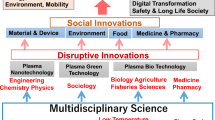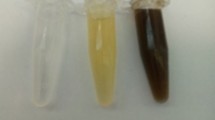Abstract
The chemical reduction of single-charged ions of metal (Ar+) under the conditions of a hydrodynamic mode on a rotating cylindrical dielectric (D) specimen is first studied. The partial manifestation of the effect of the hydrodynamical rate limitation (HDRL) of silver deposition has been determined. It has been established that the complete manifestation of the HDRL (V Ag = 0) effect is blocked by the development of the process of the concentration increasing of the electro-active particles in the reactionary zone due to the increase of the amount of collisions of the noncompact silver deposit (growing in the reactor volume) and the oxidation products of the reducer (inverted sugar) with a surface of a compact Ag layer on the D specimen. The results of this research confirm the conceptions concerning the mechanism of the HDRL phenomenondue to the repulsion of electro-active particles of silver from the reactionary layer at high speeds of rotation.
Similar content being viewed by others
References
Beshentseva, O.A., Kalugin, V.D., and Opaleva, N.S., Peculliarities of Kinetics of Chemical Reduction of Metals from Solutions on Dielectrics under Conditions of a Critical Hydrodynamical Mode, Visnik Kharkivskogo Nats. Univ., Khim., 2005, vyp. 12(35), no. 648, pp. 127–130.
Kalugin, V.D. and Beshentseva, O.A., Analysis of Kinetic and Energetic Factors During Metal Reduction under a Hydrodynamical Mode, Ukrain. Khim. Zh., 2009, vol. 75, no. 1, pp. 33–37.
Shalkauskas, M. and Vashkyalis, A., Khimicheskaya matallizatsiya plastmass (Chemical plastic plating), Leningrad: Khimiya, 1985.
Sergeev, G.B., Nanokhimiya (Nanochemistry), izd. vtoroye, Moscow: Izd-vo MGU, 2007.
Ardamatskii, A.L., Izgotovlenie opticheskikh detalei (Production of Optical Workpieces), ucheb. posobie, Fainberg, S.I. (Ed.), Moscow: Gos. Izd-vo Oboron. Promysh., 1955, pp. 465–477.
Beshentseva, O.A. and Kalugin, V.D., Kinetic Regularities of the Process of Chemical Reduction of Tin on Dielectrics by the Reaction of Disproportioning, Vestnik L’vovskogo Univ., Ser. Khim., L’vov: 2002, no. 42, part 2, pp. 233–236.
Levich, V.G., Fiziko-khimicheskaya gidrodinamika (Physico-Chemical Hydrodynamics), Moscow: Fizmatgiz, 1959.
Dorfman, L.A., Gidrodinamicheskoe soprotivlenie i teplootdacha vrashchayushchikhsya tel (Hydrodynamic Resistance and Heat Transfer of Rotating Solids), Moscow: Fizmatgiz, 1960.
Kuntii, O.I., Elektrokhimiya ta morfologiya dispersnikh metaliv: Monografiya (Electrochemistry and Morphology of Dispersive Metals: Monography), L’viv: Izd. Nats. Univ. “L’vivska politekhnika”, 2008.
Author information
Authors and Affiliations
Corresponding author
Additional information
Original Russian Text © O.A. Beshentseva, V.D. Kalugin, N.S. Opaleva, O.V. Sidorenko, 2010, published in Elektronnaya Obrabotka Materialov, 2010, No. 1, pp. 19–23.
About this article
Cite this article
Beshentseva, O.A., Kalugin, V.D., Opaleva, N.S. et al. The peculiarities of the kinetics of silver chemical deposition on dielectrics with various technologies of the surface activation. Surf. Engin. Appl.Electrochem. 46, 16–20 (2010). https://doi.org/10.3103/S1068375510010035
Received:
Accepted:
Published:
Issue Date:
DOI: https://doi.org/10.3103/S1068375510010035




